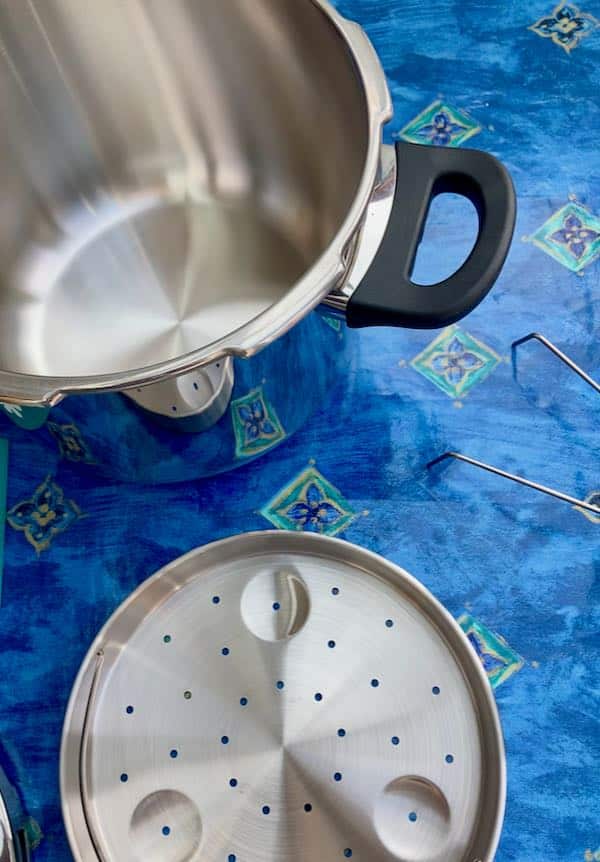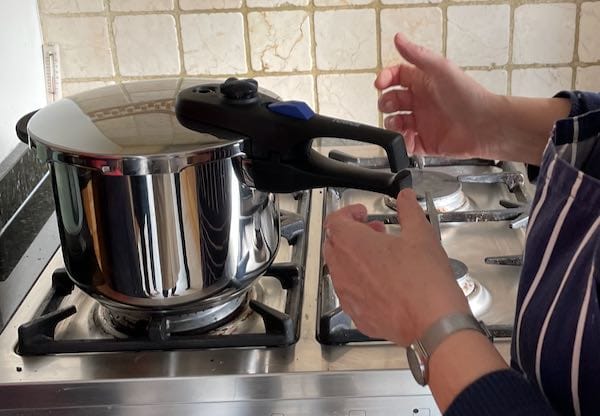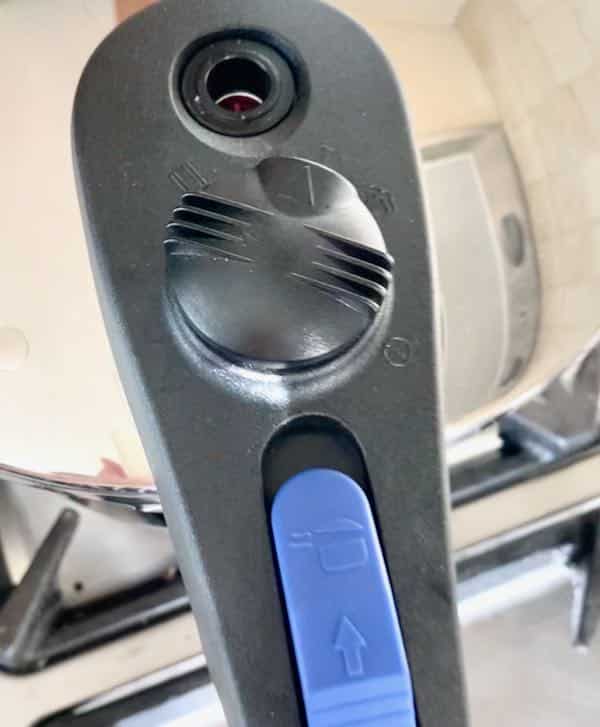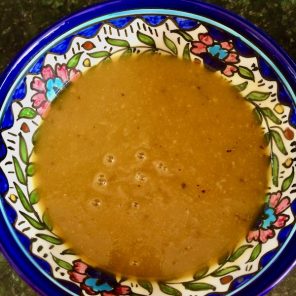Is using a pressure cooker to prepare meals a good option? We set out to find out more.
One of my favourite recipes for an orange cake suggested cooking the oranges for 3 hours. Three hours! There had to be a better way of doing it.
I was given a pressure cooker as a wedding present from my lovely boss many moons ago. I use it regularly but for a fairly limited number of recipes. I’m now on a mission to try cooking many more meals using a pressure cooker.
A group of 5 of us got together to put a Tower Pressure Cooker through its paces. Could the pressure cooker stand its ground against other ‘gadgets’?
Your memories of cooking with pressure cookers may be the stuff of nightmares. In times gone by pressure cookers had few controls and seemed more like fiery dragons and were difficult to use. But boy have pressure cookers changed.
Whilst older versions could only be used on conventional hobs, the Tower Pressure Cooker we tried can be used on all types of hobs including induction and the steam can be released in a controlled manner. It is made of stainless steel rather than aluminium.
How does a pressure cooker work?
“The steam trapped inside the pressure cooker builds up pressure to twice that of our normal atmosphere, so the temperature of the liquid can rise above the boiling point of water (100C/212F). Heat cannot escape, so the cooking temperature is maintained with minimal energy input”. (BBC Food).
Bottom line, the cooker cooks foods under pressure in about a third of the time of a conventional hob or in an oven. Flavours are intensified and nutrients retained (albeit in the liquid).





Putting the Tower Pressure Cooker through its paces
We decided to cook soup, a chicken stew and to prepare oranges for an orange cake recipe.
We aimed to unpack, wash and use the pressure cooker for our recipes whilst working out instructions from the manual.
Our first mistake was in placing the inner ring correctly meaning steam was escaping around the handle. After reading the fitting instructions properly, we started again.
This pressure cooker has two settings I and II. More delicate items are cooked on setting I. For some foods you need to reduce the steam quickly, others you need to wait until it has cooled down a little.
The steam release takes a bit of getting used to. Turning the dial to the right will release steam very quickly if used immediately after cooking. Otherwise, wait a few minutes for a slow release.

The Trial
I make soup in my pressure cooker several times a week. Vegetables are chopped into equal sizes and flavourings added. No stock needed!
We added water up to the useful minimum water level mark and brought to pressure. Whilst a pressure cooker is quicker to use, you do need to take into account the time to bring to pressure – about 4 minutes in this case.
How can you tell when it has got to pressure? The steam escapes gently and makes a sound almost like a whistle, the Tower then gently clicks and it’s at pressure
We cooked the soup for 6 minutes then released the steam quickly. Woosh! We hadn’t quite realised that the steam would exit from the side of the gauge rather than the top. It will be so important to position the pressure cooker steam outlet away from the body.

The soup is perfectly cooked and ready for making into a puree and seasoning.
Oranges
Now to tackle that orange cake recipe. We cut up the fruit and added water to the minimum level and brought to pressure. It took just 10 minutes cooking time to soften the oranges.



What a time saver the pressure cooker will be when making marmalade, the oranges soften so quickly.
Chicken Stew
We used chicken thighs with chopped onions and peppers and a sweet and sour sauce with garlic. We were less successful on our first trial of the stew after following the recommended cooking time in the manual – 15 minutes. We gave it an extra 10 and it came out perfectly.


Rice
I was a little concerned about cooking rice but it came out perfectly! I discovered that you could use 500 ml of water (less than the minimum mark inside the pan). I soaked the basmati rice first, then cooked for 5 minutes after it had come to pressure. The rice grains were beautifully separated and fragrant.
Our Verdict
A pressure cooker is a real boon for preparing many foods, reducing time and even improving the flavour. The cost of around £50 would soon be recouped – recent research suggests payback within 18 months.
We’d recommend seeking out more recipes and experimenting, leaving the cooker on the hob as a reminder to use it. I’ve been trying out a whole range of recipes. I now know when the pressure cooker has reached temperature – a subtle click and when the steam has released naturally – another click. The more I use it, the more I am impressed.
Tower Pressure Cooker Plus Points
- Simple construction
- Easy to use
- Easy to clean
- Reasonably priced
- Can be used on any hob
- Useful minimum and maximum guides.
Tower Pressure Cooker – Could be improved
- Markings for power level could be clearer – black on black
- Stem venting for quick release to the side – guide to show where to place cooker to avoid steam going towards the face.
- Instruction book is fairly limited.
Our Tower Pressure cooker is the 6 litre express which will be ideal for a family of four. It is one of the more simple versions and costs £54.99 from the Tower Website. Severn Bites Blog readers can get a 20% discount using code SEVERNBITES

Quick Pressure Cooker Sweet Potato Soup
Equipment
- 1 Pressure cooker Use code SEVERNBITES for 20% discount
- 1 Chopping board
- 1 Knife
- 1 Blender or food processor
Ingredients
- 1 large sweet potato
- 1 large red onion
- 2 medium peppers
- 30 ml tamarind paste
- 1 clove garlic
- 5 ml chilli sauce or to taste Use any chilli sauce you might have
- salt and pepper to taste
- 500 ml water
Instructions
- Peel the sweet potato and cut into 1 cm slices.
- Peel and chop onion. Peel garlic. Chop pepper into 2 cm pieces.
- Place vegetables into the pressure cooker. Add the water, chilli and the tamarind
- Close the lid and choose appropriate cooking pressure. (II (high) on the Tower Pressure Cooker)
- Bring to steaming point on your hob. Time 6 minutes from when it has reached steaming point. Turn off heat.
- Release the steam slowly
- Place mixture in blender or food processor and blend. You'll probably need more water
- Place back in the pressure cooker and taste. Add salt, pepper and chilli as needed. Serve.
Notes
And More
A big thank you to Tower for providing the pressure cooker. All comments however are our own.
In a recent BBC Radio 4 Food programme on low energy cookers, Nicholas Balfe owner of Holm Restaurant in South Pemberton was asked to try cooking with a pressure cooker in his restaurant. He was suitably impressed and is now considering buying an industrial sized one. So, it won’t just save energy in a domestic setting but in restaurants too!
You might see mention of Instant Pot Cookers. These function in the same way as a stove top cooker but sit on an electric base.
I have found the Catherine Phipps’ book invaluable. A great mix of both traditional and modern dishes, it is particularly helpful on using smaller amount of liquid. I have the Kindle version.

1 thought on “Will a pressure cooker change the way you cook?”